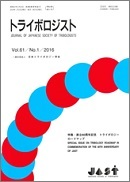Volume 59, Issue 8
Special Issue on Tribology of Hair and Beauty
Displaying 1-14 of 14 articles from this issue
- |<
- <
- 1
- >
- >|
Announcement
-
2014 Volume 59 Issue 8 Pages K8
Published: August 15, 2014
Released on J-STAGE: February 23, 2018
Download PDF (2979K)
Contents
-
2014 Volume 59 Issue 8 Pages M8
Published: August 15, 2014
Released on J-STAGE: February 23, 2018
Download PDF (256K)
Serial Messages to Tribologists
-
2014 Volume 59 Issue 8 Pages 463
Published: August 15, 2014
Released on J-STAGE: February 23, 2018
Download PDF (540K)
Special Issue on Tribology of Hair and Beauty
-
2014 Volume 59 Issue 8 Pages 464
Published: August 15, 2014
Released on J-STAGE: February 23, 2018
Download PDF (522K)
Explanation
-
2014 Volume 59 Issue 8 Pages 465-470
Published: August 15, 2014
Released on J-STAGE: February 23, 2018
Download PDF (809K) -
2014 Volume 59 Issue 8 Pages 471-476
Published: August 15, 2014
Released on J-STAGE: February 23, 2018
Download PDF (923K) -
2014 Volume 59 Issue 8 Pages 477-483
Published: August 15, 2014
Released on J-STAGE: February 23, 2018
Download PDF (1093K) -
2014 Volume 59 Issue 8 Pages 484-489
Published: August 15, 2014
Released on J-STAGE: February 23, 2018
Download PDF (1407K) -
2014 Volume 59 Issue 8 Pages 490-495
Published: August 15, 2014
Released on J-STAGE: February 23, 2018
Download PDF (1400K) -
2014 Volume 59 Issue 8 Pages 496-501
Published: August 15, 2014
Released on J-STAGE: February 23, 2018
Download PDF (1480K)
Essay The Tribo-Soshi, Essays from Tribologists
-
2014 Volume 59 Issue 8 Pages 502-506
Published: August 15, 2014
Released on J-STAGE: February 23, 2018
Download PDF (789K)
Original Contribution
-
2014 Volume 59 Issue 8 Pages 507-514
Published: August 15, 2014
Released on J-STAGE: February 23, 2018
Download PDF (1612K)
Short Paper
-
2014 Volume 59 Issue 8 Pages 515-520
Published: August 15, 2014
Released on J-STAGE: February 23, 2018
Download PDF (910K)
Report of the Society
-
2014 Volume 59 Issue 8 Pages 521-522
Published: August 15, 2014
Released on J-STAGE: February 23, 2018
Download PDF (278K)
- |<
- <
- 1
- >
- >|
